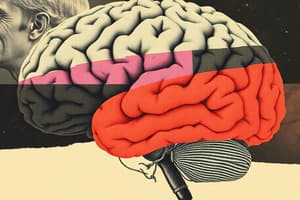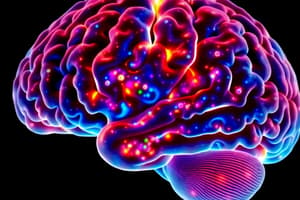Podcast
Questions and Answers
What is the primary function of the limbic system?
What is the primary function of the limbic system?
- Processes visual stimuli
- Regulates motivated behaviors (correct)
- Regulates sensory information
- Coordinates motor movements
Which of the following structures is NOT part of the basal ganglia?
Which of the following structures is NOT part of the basal ganglia?
- Cingulate cortex (correct)
- Putamen
- Nucleus accumbens
- Amygdala
What is the main role of commissures in the telencephalon?
What is the main role of commissures in the telencephalon?
- Connect two hemispheres (correct)
- Regulate endocrine functions
- Relay sensory information
- Connect various lobes of the brain
Which lobe of the cerebral hemispheres is primarily involved in processing visual information?
Which lobe of the cerebral hemispheres is primarily involved in processing visual information?
Which component is primarily responsible for sensory relay functions?
Which component is primarily responsible for sensory relay functions?
What is the function of the hypothalamus in relation to motivation?
What is the function of the hypothalamus in relation to motivation?
Which structure is included in the basal ganglia?
Which structure is included in the basal ganglia?
Which region is primarily responsible for complex cognitive functions?
Which region is primarily responsible for complex cognitive functions?
What is predominantly responsible for action potentials jumping from one node of Ranvier to the next?
What is predominantly responsible for action potentials jumping from one node of Ranvier to the next?
What effect do demyelinating diseases have on nerve conduction?
What effect do demyelinating diseases have on nerve conduction?
Which of the following is necessary for depolarization to occur during an action potential?
Which of the following is necessary for depolarization to occur during an action potential?
At what membrane potential does depolarization typically begin?
At what membrane potential does depolarization typically begin?
What happens to the conduction of an action potential when current leaks out between the nodes of Ranvier?
What happens to the conduction of an action potential when current leaks out between the nodes of Ranvier?
How does increased excitability affect the likelihood of an action potential?
How does increased excitability affect the likelihood of an action potential?
Which ion channels are primarily located at the nodes of Ranvier?
Which ion channels are primarily located at the nodes of Ranvier?
What is the membrane potential at which the excitability is considered high?
What is the membrane potential at which the excitability is considered high?
What is the wavelength of the laser used in the studies mentioned in the content?
What is the wavelength of the laser used in the studies mentioned in the content?
What was the energy dose delivered with the 810 nm laser during treatment?
What was the energy dose delivered with the 810 nm laser during treatment?
Which outcome was measured to evaluate the effects of photobiomodulation after TBI at 7 days?
Which outcome was measured to evaluate the effects of photobiomodulation after TBI at 7 days?
What was the frequency mode used in one of the laser treatments for mice with TBI?
What was the frequency mode used in one of the laser treatments for mice with TBI?
What parameter was used to express the results from the neurological severity score (NSS) assessment?
What parameter was used to express the results from the neurological severity score (NSS) assessment?
What initiates the release of neurotransmitters at the axon terminal?
What initiates the release of neurotransmitters at the axon terminal?
What happens after the axon terminal depolarizes?
What happens after the axon terminal depolarizes?
What role do Ca2+ ions play in neurotransmitter release?
What role do Ca2+ ions play in neurotransmitter release?
Which statement best summarizes the flow of events during neurotransmitter release?
Which statement best summarizes the flow of events during neurotransmitter release?
What triggers the opening of voltage-gated Ca2+ channels?
What triggers the opening of voltage-gated Ca2+ channels?
What occurs first in the neurotransmitter release process?
What occurs first in the neurotransmitter release process?
What must happen before neurotransmitter release can occur?
What must happen before neurotransmitter release can occur?
Which component is essential for the triggering of neurotransmitter release?
Which component is essential for the triggering of neurotransmitter release?
At what age does the reduction in gray matter typically begin in the dorsal parietal and sensorimotor regions?
At what age does the reduction in gray matter typically begin in the dorsal parietal and sensorimotor regions?
What type of experience is directly related to the brain's organization primarily due to genetic factors?
What type of experience is directly related to the brain's organization primarily due to genetic factors?
Which of the following factors does NOT influence the effects of brain injury?
Which of the following factors does NOT influence the effects of brain injury?
According to the Kennard Principle, recovery from brain injury is most likely if the injury occurs during which period?
According to the Kennard Principle, recovery from brain injury is most likely if the injury occurs during which period?
Which statement about the plasticity of the brain following early brain injury is accurate?
Which statement about the plasticity of the brain following early brain injury is accurate?
What significant change occurs in the brain due to normal aging?
What significant change occurs in the brain due to normal aging?
Which type of light therapy is known for stimulating and healing brain tissue?
Which type of light therapy is known for stimulating and healing brain tissue?
What is NOT a consequence of reduced education on brain structure during aging?
What is NOT a consequence of reduced education on brain structure during aging?
Which of the following factors may have a role in the response of old and young brains to experiences?
Which of the following factors may have a role in the response of old and young brains to experiences?
What effect does prenatal experience have on brain development?
What effect does prenatal experience have on brain development?
Flashcards are hidden until you start studying
Study Notes
Telencephalon
- Comprises the cerebral cortex, characterized by gyri (ridges) and sulci (grooves)
- Contains commissures that connect the two hemispheres of the brain
- Responsible for complex cognitive functions
- Consists of the cerebrum, limbic system, and basal ganglia
Cerebral Lobes
- The cerebrum is divided into four lobes: frontal, temporal, parietal, and occipital
- Each lobe has specialized functions related to cognition, perception, and motor control
Limbic System
- Regulates motivated behaviors and emotional responses
- Key structures include:
- Amygdala (emotion processing)
- Hippocampus (memory formation)
- Cingulate cortex, fornix, septum, mammillary bodies
Basal Ganglia
- Plays an essential role in regulating movement
- Major components include:
- Amygdala
- Dorsal striatum (caudate, putamen, globus pallidus)
- Ventral striatum (nucleus accumbens, olfactory tubercle)
Diencephalon
- Contains the thalamus, which serves as a sensory relay with reciprocal connections
- Hypothalamus is located above the pituitary gland and is crucial for endocrine functions and motivated behaviors
- Also includes mammillary bodies and optic chiasm
Synaptic Communication
- Action potentials cause neurotransmitter release from axon terminals
- Voltage-gated Ca2+ channels open, allowing calcium ions to enter the cell
- Neurotransmitter molecules cross the synaptic cleft to bind to receptors on the postsynaptic cell
Brain Development Patterns
- Gray matter reduction starts at ages 6-7 in specific brain regions
- White matter increases from ages 6-7 and continues through adolescence
- Decline in gray matter may persist until age 30 or even 60
Mechanisms of Brain Development
- Experience-expectant: Brain develops based on expected environmental stimuli
- Experience-dependent: Development influenced by individual experiences
Environmental Influences
- Brain organization differs in animals raised in natural versus laboratory conditions
- Complex environments promote different structural changes compared to impoverished settings
- Prenatal and postnatal experiences significantly shape brain development
Brain Injury and Plasticity
- The Kennard Principle suggests that functions can often be spared when injury occurs during infancy
- Outcomes of brain injury are influenced by:
- Specific brain region affected
- Timing of the injury during development
- Age and type of behavior assessed
Recovery from Early Brain Injuries
- Complete function recovery is possible if injury occurs during neurogenesis
- Damage during migration and differentiation can result in severe outcomes
- The brain can adapt by reorganizing intact circuits and generating new cells to compensate for loss
Aging and the Nervous System
- Normal aging leads to a reduction in brain weight, loss of gray matter, decline in dendritic density, and slower synaptic speed
- Education appears to correlate positively with reduced cerebral cortex atrophy
Photobiomodulation
- Involves the use of red or near-infrared light to heal and regenerate injured brain tissue
- Mechanisms of action include mitochondrial stimulation, improvement of blood flow, and activation of signaling pathways
- It has been shown to enhance neurogenesis and synaptogenesis following traumatic brain injury in experimental models
Studying That Suits You
Use AI to generate personalized quizzes and flashcards to suit your learning preferences.




